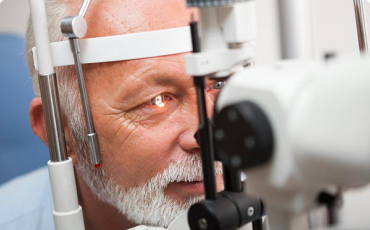Have you been experiencing extreme dizziness (vertigo) throughout your day? Some people suffer from dizziness regularly, feeling as if everything around them is spinning and that the ground below them is moving. Their dizziness is often accompanied by nausea and blurred vision, making it difficult for them to do anything during their day, including go to work.
Oftentimes, individuals experiencing these debilitating symptoms are told they are experiencing Vestibular Migraine or Migraine-Associated Vertigo.
They try everything to treat the symptoms and condition, including taking medications, changing their diet, increasing the amount of sleep they get each night, eliminating caffeine, incorporating exercise into their daily routine, and managing their stress. However, some still experience symptoms despite these efforts.

Could Your Eyes Be Causing Your Vertigo?
While many people experiencing headaches and dizziness are told the reason is due to vestibular migraines, this condition only affects 1 percent of people in the U.S.
If you are someone suffering from headaches, dizziness, and nausea throughout your day, it’s much more likely that you have Binocular Vision Dysfunction (BVD). BVD is a condition where the eyes do not work together to create one clear image, and affects about 20 percent of individuals in the U.S.
Have you ever wondered why, despite having two eyes, you only see one image? This is because our brain is able to transform two separate images into one image – also known as binocular vision. However, this can only work when the eyes are in perfect alignment and many people actually have a very subtle misalignment between their eyes. The result of any type of misalignment, no matter how small, means that our brain has difficulty creating one clear image. This leads to eye strain and dizziness, headaches, double-vision, nausea, and a whole host of other symptoms.
For people who have BVD, because their eyes are not in alignment (not in sync) their eyes will transmit two images to the brain that are in slightly different positions to one another. The brain won’t accept this situation and responds by forcing the eye aligning muscles to fix the problem by realigning the eyes. The realignment is only temporary and misalignment then recurs, which is followed closely by realignment.
So there becomes a continuous cycle of image misalignment and realignment, which makes the brain believe things are moving, and as you can imagine, puts a great deal of strain on the eye muscles. The eyes become tired and sore, which can lead to a variety of unpleasant and sometimes painful symptoms, such as eye strain dizziness, vertigo eye strain, headaches, and nausea.
What Causes Visual Vertigo?
Visual vertigo is defined as a disorder characterized by symptoms that include dizziness, unsteadiness, and disorientation, caused by visual triggers.
While visual vertigo can be caused by a variety of factors, people with BVD experience visual vertigo due to their eyes being misaligned. Again, this misalignment is usually very subtle. When our eyes are misaligned, they send two slightly different images to our brain, which then tries to force the eye aligning muscles to fix the problem by realigning our eyes. This creates a continuous cycle of image misalignment and realignment, repeatedly straining the eye muscles and producing symptoms of headaches and dizziness.
BVD can be the result of your facial asymmetry (where one eye is higher than the other), nerve or eye muscle abnormality (a common condition many people are born with), or it can develop as a result of stroke, brain injury, or a similar neurological disorder.

Can Eye Problems Cause Vertigo?
Yes, any type of eye strain or issue can cause vertigo (as well as other neurological symptoms). This is because any issue between the eyes and brain can create dizziness.
Can Eye Strain Cause Vertigo?
Yes, eye strain can easily cause vertigo. When our eye muscles are repeatedly working to align and correct themselves, this can lead to not only vertigo but also feeling nauseous and off-balance.
Common Symptoms for Adults with Binocular Vision Dysfunction
There are several symptoms associated with BVD in adults, which typically include the below. Some individuals experience all of these symptoms, while others experience only a few, such as headaches, dizziness, and nausea. These symptoms are also very similar to those associated with vestibular migraines and vertigo.
- Headaches
- Dizziness
- Nausea
- Anxiety
- Sensitivity to light
- Difficulty with balance / unsteady walking
- Pain in the neck
- Frequent head tilt
- Motion sickness
- Difficulty reading and learning

Treatment For Your Eye Strain and Dizziness
BVD is treated by correcting the misalignment between your eyes with mico-prism lenses. These specialized lenses specifically bend light in a way that the image seen by your eye is moved into the position it needs to be in so that the image becomes realigned. Unlike your standard eyeglass prescription, the specialized aligning lenses treat your Binocular Vision Dysfunction, along with any additional vision impairments, to allow your eyes to work together. When your eyes are working together to create one clear image, there’s no longer a constant struggle to realign vision. Ultimately, the glasses eliminate the need for your eye muscles to strain, resulting in marked relief from dizziness, headaches, nausea, and any other symptoms related to BVD.
At Vision Specialists of Michigan, we make our treatment easy for patients of all ages. Our compassionate doctors will complete a thorough NeuroVisual Examination to determine the extent of your vision misalignment (or your child’s) and prescribe you with the specialized aligning lenses. Every person can receive treatment for BVD, as long as they are old enough to wear the specialized aligning glasses (and be able to tell or show the doctor how they feel).
The average patient will notice a 50 percent reduction of symptoms by the end of their first visit. The aligning lenses are fine-tuned and perfected for the patient over the next several visits, helping the individual to continue feeling better and eliminating the unpleasant symptoms of BVD.










